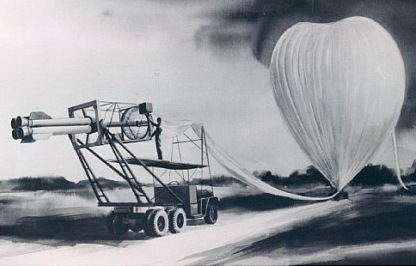Purpose of the flight and payload description
Project Far Side was a series of six low-cost, all-solid-fuel, four-stage, balloon-launched sounding rockets, each launched from a stratospheric balloon. It was based on the rockoon concept: when each balloon reached its maximum altitude of about 100,000 feet, the rockets fired through the balloon.
Each Far Side rocket carried a scientific payload of three to five pounds of instruments for measuring cosmic rays, electromagnetic radiations, interplanetary gases, and other phenomena.
Details of the balloon flight
Balloon launched on: 10/22/1957
Launch site: Eniwetok Air Base, Marshall Islands
Balloon launched by: General Mills Inc.
Balloon manufacturer/size/composition: Zero Pressure Balloon General Mills
Flight identification number: GMI - 2292
End of flight (L for landing time, W for last contact, otherwise termination time): 10/22/1957
Landing site: Rocket succesfully launched. 4.000 miles apogee apparently achieved. Only confirmed up to 1.000 miles.
Payload weight: 2400 lbs
Rocket succesfully launched. 4.000 miles apogee apparently achieved. Only confirmed up to 1.000 miles.
External references
- Farside project International missile and spacecraft guide, pag. 73, (1960)
3652If you consider this website interesting or useful, you can help me to keep it up and running with a small donation to cover the operational costs. Just the equivalent of the price of a cup of coffee helps a lot.


